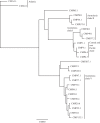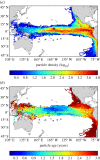Predicting connectivity of green turtles at Palmyra Atoll, central Pacific: a focus on mtDNA and dispersal modelling
- PMID: 24451389
- PMCID: PMC3928928
- DOI: 10.1098/rsif.2013.0888
Predicting connectivity of green turtles at Palmyra Atoll, central Pacific: a focus on mtDNA and dispersal modelling
Abstract
Population connectivity and spatial distribution are fundamentally related to ecology, evolution and behaviour. Here, we combined powerful genetic analysis with simulations of particle dispersal in a high-resolution ocean circulation model to investigate the distribution of green turtles foraging at the remote Palmyra Atoll National Wildlife Refuge, central Pacific. We analysed mitochondrial sequences from turtles (n = 349) collected there over 5 years (2008-2012). Genetic analysis assigned natal origins almost exclusively (approx. 97%) to the West Central and South Central Pacific combined Regional Management Units. Further, our modelling results indicated that turtles could potentially drift from rookeries to Palmyra Atoll via surface currents along a near-Equatorial swathe traversing the Pacific. Comparing findings from genetics and modelling highlighted the complex impacts of ocean currents and behaviour on natal origins. Although the Palmyra feeding ground was highly differentiated genetically from others in the Indo-Pacific, there was no significant differentiation among years, sexes or stage-classes at the Refuge. Understanding the distribution of this foraging population advances knowledge of green turtles and contributes to effective conservation planning for this threatened species.
Keywords: Chelonia mydas; control region; feeding ground; marine turtle; mixed stock analysis; ocean currents.
Figures



Similar articles
-
Seascape Genetics and the Spatial Ecology of Juvenile Green Turtles.Genes (Basel). 2020 Mar 5;11(3):278. doi: 10.3390/genes11030278. Genes (Basel). 2020. PMID: 32150879 Free PMC article.
-
Phylogeography, Genetic Diversity, and Management Units of Hawksbill Turtles in the Indo-Pacific.J Hered. 2016 May;107(3):199-213. doi: 10.1093/jhered/esv091. Epub 2015 Nov 27. J Hered. 2016. PMID: 26615184 Free PMC article.
-
Turtle groups or turtle soup: dispersal patterns of hawksbill turtles in the Caribbean.Mol Ecol. 2009 Dec;18(23):4841-53. doi: 10.1111/j.1365-294X.2009.04403.x. Epub 2009 Nov 2. Mol Ecol. 2009. PMID: 19889039
-
Cadmium in tissues of green turtles (Chelonia mydas): A global perspective for marine biota.Sci Total Environ. 2018 Oct 1;637-638:389-397. doi: 10.1016/j.scitotenv.2018.04.317. Epub 2018 May 9. Sci Total Environ. 2018. PMID: 29753227 Review.
-
Phylogeny, biogeography and methodology: a meta-analytic perspective on heterogeneity in adult marine turtle survival rates.Sci Rep. 2018 Apr 11;8(1):5852. doi: 10.1038/s41598-018-24262-w. Sci Rep. 2018. PMID: 29643352 Free PMC article.
Cited by
-
Distribution of genetic diversity reveals colonization patterns and philopatry of the loggerhead sea turtles across geographic scales.Sci Rep. 2020 Oct 22;10(1):18001. doi: 10.1038/s41598-020-74141-6. Sci Rep. 2020. PMID: 33093463 Free PMC article.
-
Seascape Genetics and the Spatial Ecology of Juvenile Green Turtles.Genes (Basel). 2020 Mar 5;11(3):278. doi: 10.3390/genes11030278. Genes (Basel). 2020. PMID: 32150879 Free PMC article.
-
Identifying genetic lineages through shape: An example in a cosmopolitan marine turtle species using geometric morphometrics.PLoS One. 2019 Oct 7;14(10):e0223587. doi: 10.1371/journal.pone.0223587. eCollection 2019. PLoS One. 2019. PMID: 31589640 Free PMC article.
-
Modeling the active dispersal of juvenile leatherback turtles in the North Atlantic Ocean.Mov Ecol. 2019 Feb 28;7:7. doi: 10.1186/s40462-019-0149-5. eCollection 2019. Mov Ecol. 2019. PMID: 30858978 Free PMC article.
-
Mixed stock analysis of juvenile green turtles aggregating at two foraging grounds in Fiji reveals major contribution from the American Samoa Management Unit.Sci Rep. 2019 Feb 28;9(1):3150. doi: 10.1038/s41598-019-39475-w. Sci Rep. 2019. PMID: 30816199 Free PMC article.
References
-
- Cowen RK, Gawarkiewicz G, Pineda J, Thorrold SR, Werner FE. 2007. Population connectivity in marine systems: an overview. Oceanography 20, 14–21. (10.5670/oceanog.2007.26) - DOI
-
- Staaterman E, Paris CB. 2013. Modelling larval fish navigation: the way forward. ICES J. Mar. Sci. (10.1093/icesjms/fst103) - DOI
Publication types
MeSH terms
Substances
LinkOut - more resources
Full Text Sources
Other Literature Sources
Research Materials

